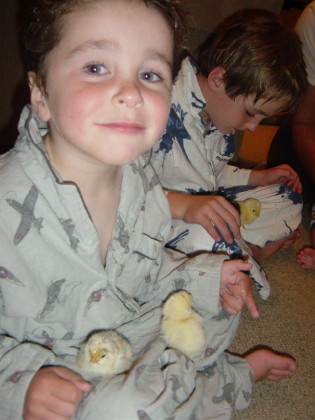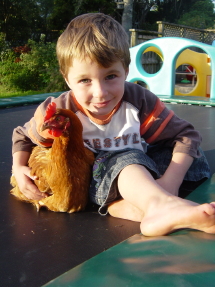Where to Get Your Chicks
You can buy “point of lay” chickens (teenagers about to start laying) from many battery chicken farms, Trademe, or ask around to find local breeders. The price of purebred chickens will start at around $20 and go upwards of $50. Try visiting Rarebreeds.co.nz to search for particular breeds. Hyline Browns (the battery type) normally can be bought for around $18. Remember Hyline Browns will lay well for two years and then they are basically ‘spent’, purebreds will keep laying, well into old age.
Starting with Chicks
Starting with day old Chicks Chicks are very cute. Hatching or obtaining day old chicks is a great experience for kids to enjoy. They require much more tender loving care than full-grown hens and it’ll take 5-6 months before they start laying. Some battery farms will sell day old chicks at around $6 each. The good thing is they have already been sexed so you are guaranteed hens. You can keep young chicks almost anywhere: their small size makes them easy to handle! A large cardboard box will suffice for the first few weeks. They grow quickly, though, and by the time they’re three or four weeks old they’ll be taking up a lot of space and making a big mess, so preparing a living space for them is actually quite important. (The good news is that you can transfer them to their outside coop at 4-5 weeks of age, so you won’t have to deal with the mess for too long. Baby chicks need to be protected from drafts but still need adequate ventilation. This can be in the form of a cardboard box with holes for ventilation, a disused rabbit run or even a plastic or rubber storage bin. Whatever housing solution you go with, make sure it provides 2 square feet per chick. It sounds like an awful lot, but as they get older (and bigger) you’ll realise why this is necessary.
A heat source
Baby chicks need to be kept pretty hot. Think sauna! A 250-watt infrared heat lamp is the best way to achieve this, placed right in the middle of their living area and suspended off the ground. I bought a heat lamp bulb from Mitre 10 for around $15 ( the type used in bathrooms). Pay close attention to how your chicks behave. If they’re all crowded together directly under the heat source, they’re cold. Lower the heat lamp or add another one. If they’re around the edges of the brooder, avoiding the heat and each other like the plague, they’re too hot! Raise the heat lamp. A happy flock will happily be exploring all around the brooder. And please do not listen to anyone that tells you a regular old 60 watt bulb will suffice! They really need a lamp intended to produce heat. Absorbent bedding Baby chicks are big poohers, so make sure to line the floor of their housing unit with an absorbent material such as sawdust or straw. Chicks need to be fed special chick starter mash and have access to clean drinking water at all times. Make sure you use a shallow water container to prevent chicks drowning. Don’t forget that your baby chicks need less and less heat as time goes by. Continue tuning into their behavioral cues as described above and you’ll know how to tweak their heat. Also, keep in mind that some of your chicks will develop faster than others, requiring less heat, while the “runty” ones will want to be closer to the heat lamp. I hang an old rope mop inside the box. The chicks love to huggle underneath it as if it was their mother.
living area and suspended off the ground. I bought a heat lamp bulb from Mitre 10 for around $15 ( the type used in bathrooms). Pay close attention to how your chicks behave. If they’re all crowded together directly under the heat source, they’re cold. Lower the heat lamp or add another one. If they’re around the edges of the brooder, avoiding the heat and each other like the plague, they’re too hot! Raise the heat lamp. A happy flock will happily be exploring all around the brooder. And please do not listen to anyone that tells you a regular old 60 watt bulb will suffice! They really need a lamp intended to produce heat. Absorbent bedding Baby chicks are big poohers, so make sure to line the floor of their housing unit with an absorbent material such as sawdust or straw. Chicks need to be fed special chick starter mash and have access to clean drinking water at all times. Make sure you use a shallow water container to prevent chicks drowning. Don’t forget that your baby chicks need less and less heat as time goes by. Continue tuning into their behavioral cues as described above and you’ll know how to tweak their heat. Also, keep in mind that some of your chicks will develop faster than others, requiring less heat, while the “runty” ones will want to be closer to the heat lamp. I hang an old rope mop inside the box. The chicks love to huggle underneath it as if it was their mother.
“Outside” time
After the chicks are 2-3 weeks old, if it’s warm outside and sunny, give them some outside time. Being outside encourages the baby chickens to produce adult feathers more quickly. Put them in a wire cage, I use an old rabbit run. Place the run in the sun, making sure they have access to water and shade if they need it. They’ll absolutely love pecking around in the grass. At this age they’re VERY good at flying and VERY susceptible to predators, hawkes, cats, magpies, rats or stoats. Avoid windy days as they quickly get cold. By 4-5 weeks of age your chickens are ready to move outside full-time. You’ll be thrilled to get them out of the house!
Written by Janet from www.greenurbanliving.co.nz
I am a Landscape Architect with a Masters in Environmental Planning and a passion for permaculture. My business, Green Urban Living (www.greenurbanliving.co.nz), is all about showing how even city dwellers can make a real difference to their families health, wallet and the environment. I run keeping chicken workshops, chicken dome building workshops, organic gardening courses, and pizza oven courses. I also provide landscape and permaculture design services. Green Urban Living.co.nz provides a knowledge sharing community forum (http://www.greenurbanliving.co.nz/forum/index.php), green products and lots of helpful articles and information.
The most satisfying thing for me abut the Green Urban Living approach is the amazing education for my children. My three boys, all under 7 years old, are a key part of the planting, harvesting and chicken breeding and rearing process. It is great to see the boys, friends and the neighbours wondering my ‘crop circle’ gardens munching on carrots, fresh peas, fruits and beans after school as if it is the most natural thing in the world to do.
Which of course is exactly what it is…
loading...
loading...
Tags: chickens





Voices of our community